I hate plastic engine covers, which cover practically all new car engines. They serve the purpose of making all engines look the same. Of covering up what’s under there. Which serves the purpose of stifling any interest in what’s under there.
And that serves the purpose of making cars uninteresting to the youth, especially. And they are, indeed, the future – when it comes to cars.
Make them uninterested in cars and you sever the emotional-generational connection to cars that has fueled the affection for cars that made car ownership – and driving – a defining element of American culture for generations.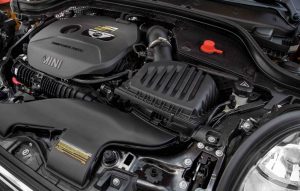
This severing being precisely what some people are determined to achieve, for they know that Americans who no longer care about cars – and driving them – have had their passion for personal mobility and the freedom it represents dulled. Such people are much easier to herd-manage like the cattle these people consider them to be.
Prior generations – including mine – became interested in cars because of what we saw under the hood. I remember being seven or eight years old and looking under the hood of my parents’ 1970 Oldsmobile 98 and seeing the engine – proudly bearing its Rocket 455 decal on the air cleaner, the block resplendently painted in gold – which was the way you could tell at a glance you were looking at an Oldsmobile V8 and not, say, a Pontiac V8 – which would be wearing a light blue hue. If you were looking at a Chevy, the visual tell would be a shade of orange (different from the shade of red-orange used by Mopar) and so on.
Each engine type could be identified at a glance by this and other visual cues, including the shape of its valve covers – a big block Chevy’s were unmistakably wide and low – and other brand-specific items such as the location of the oil filler tube (Oldsmobiles had them up front) and so on.
A lot of attention was given to making the engines look interesting. Especially those in high-performance models, which often came with beautifully chromed rocker covers and air cleaner tops, with stickers announcing the displacement and even the power. A kid seeing a Turbo-Jet 454 V8 for the first time is invariably interested in knowing more about what that is.
And so begins an interest in cars and how they work that may last a lifetime.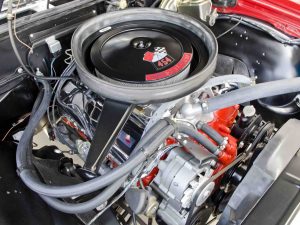
He will be inclined to spin off the wingnut that holds the chrome air cleaner lid in place – it being temptingly right there – so as to have a look at what’s under there. I know I did. With the air cleaner lid off, you can see – well, you could see – the trap doors of the big four barrel carburetor that lay beneath. I remember poking the secondary doors – I didn’t yet know they were “secondaries” – and observing them open and then snap shut when I let them go. It was very interesting to my young mind, which wanted to know more.
Which led to removing the air cleaner and – behold! – the carburetor, itself. Now you could see the throttle arm and the spring that snapped it back. One could see – in one’s mind – that pressing on the gas pedal inside the car caused the throttle arm to move – and one immediately grasped the implications, without even understanding the mechanical principles.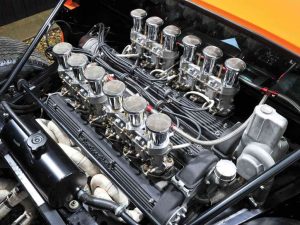
The carburetors were also different, visually as well as well as functionally, from brand to brand and model to model. Some were four barrels and some were just two. A Rochester differed from a Holley, which wasn’t the same as a Carter. If you were lucky enough to catch a glimpse under the hood of a foreign exotic car such as a Ferrari or Lamborghini, you might see what looked like a set of bagpipes in a row – the individual Webers that fed the V12 under that exotic car’s hood.
Today, all cars have the same dreary fuel injection – made by Bosch, generally. The only major difference being the number of injectors. There is no throttle arm. No spring to snap it back. In their place, sensors you cannot see – or rather, which you cannot see moving. All of them the same black plastic, hidden under plastic.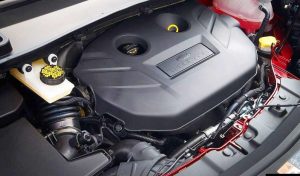
Incrementally, I gained knowledge – some of it from reading, some from just tinkering. Or watching people who knew what they were doing, doing the tinkering. Such as making adjustments or doing a tune-up themselves – which people commonly did themselves back in the ‘70s and ‘80s, in part because they could – because cars were much simpler things, in those days – but also because they were interested.
Car culture was general. Dads and sons routinely worked on the family car together on the weekend. A bond was formed – and not just between fathers and sons but between sons and cars. Anyone who was born before engines were covered up with plastic will remember this generational hand-off and will also remember how every almost-sixteen-year-old burned with desire to get his own car. 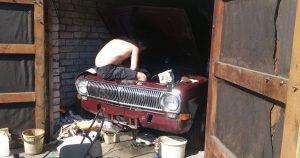
Which wasn’t so much because he was edging toward sixteen but rather because he had been interested in cars for years before and now, at last, it was going to be his turn to own his own car. It would be his and no one else’s. His ticket to drive but much more than that.
Black plastic engine covers have the same effect on this passion as a prophylactic upon the reproductive act – performed upon a plastic partner.
It is telling that passion for cars still burns bright under the hood of certain holdouts, as made by Dodge – which is one of the few car manufacturers still manufacturing cars that does not cover its engines in plastic; it even still paints them orange.
It keeps them interesting.
If only more would emulate this example.
. . . .
Got a question about cars, Libertarian politics – or anything else? Click on the “ask Eric” link and send ’em in! Or email me at [email protected] if the @!** “ask Eric” button doesn’t work!
If you like what you’ve found here please consider supporting EPautos.
We depend on you to keep the wheels turning!
Our donate button is here.
If you prefer not to use PayPal, our mailing address is:
EPautos
721 Hummingbird Lane SE
Copper Hill, VA 24079
PS: Get an EPautos magnet or sticker or coaster in return for a $20 or more one-time donation or a $10 or more monthly recurring donation. (Please be sure to tell us you want a magnet or sticker or coaster – and also, provide an address, so we know where to mail the thing!)
My eBook about car buying (new and used) is also available for your favorite price – free! Click here. If that fails, email me at [email protected] and I will send you a copy directly!


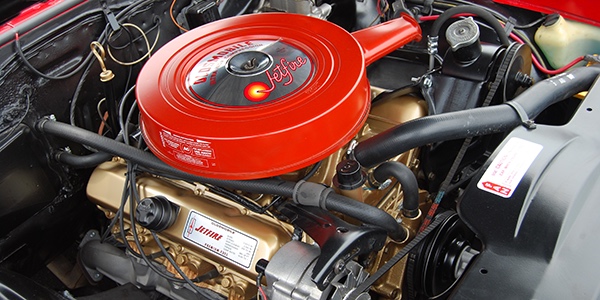









Those covers are to hide the ugly.
It reduces cost to make a single cosmetic cover and then have exactly zero cosmetic standards for all the parts under it. The part designs don’t even have to look good, just work and be cheap to manufacturer and assemble.
For me in high school it was wrench it yourself or walk – I had a 63 Alfa coupe then for several years and a factory service manual. No parent money either, my part time job $ was spent on gas oil and Alfa parts. Did my own clutch, and it bent an exhaust valve when a carb part came off and got injested. $35 for one valve was serious money in 1972! I did the head r and r, shop did the valve replacement.
Another factor behind the lack of weekend mechanics is that cars today require very little fiddling. When I had cars with carburetors, I had to fiddle a bit with their settings for summer vs winter, or adjust distributor points, and the dang things weren’t as simple as “push start and go”, as they are today. In the winter, it wasn’t easy to start the thing. In the days of engine belt driven fans, a car set up for summer would run too cold in the winter, and vice versa. Sometimes, you were in a rush or busy and not on top of all the tinkering needed, and your car would fail you.
I’m 100% with you that the plastic engine cover is worthless and despicable, however, there is also hardly ever a need to look under it. I took mine off on my Focus RS – know what I found? A black plastic head cover. That shocked me. My gas pedal and clutch pedal are made of black plastic too. It’s quite shocking. I miss what the figurative black plastic replaced; durability and quality.
Indeed, OP –
Although there is something to be said in favor of cars that do need tinkering with every now and then. It establishes more of a connection with the machine; makes it less of an impenetrable throwaway, like a cell phone. Technology can be a boon and empowering (hot and cold running water, electricity) and it can be alienating and used for authoritarian purposes. The key lies in establishing and maintaining a balance.
I maintain that cars reached a kind of apotheosis of design about 20 years ago. Since then, they have not meaningfully improved but rather chiefly become more gratuitously complex, disposable and so on. What does a new/2021 model Nissan Frontier do better than my 2002 Frontier? Does it start more readily? Is it more reliable? All it is is more complex, with more electronic crap that does not make it run more reliably or better but only makes it more expensive, unrepairable and disposable.
Whats worse than black plastic engine covers?
Black plastic intake manifolds.
Black plastic radiators.
Black plastic thermostat housings.
Black plastic accessory pulleys.
Black plastic water pump impellers.
Black plastic creaky interior trim.
Black plastic vacuum lines.
Black plastic valve covers.
Black plastic door handles.
Black plastic GEARS.
Black plastic window regulator components.
Black plastic clips and fasteners (screws muthafker use them!)
Black plastic linkages and levers.
Black plastic undercarriage covers (WHY?!?!?!)
Black plastic fuel tanks are ok though.
Anecdotal, but by 17 yr old son and his friends are severely into trucks, esp diesels. And upgrading them.
My son is fixing up a 2001 dodge cummins.
One of his friends rebuilt a 79 camaro.
They go to local car shows and constantly talk about cars.
When someone picks up a new vehicle, they swarm to check it out.
They troll the local junkyards for parts.
A few are training to be mechanics.
All is not lost.
That made my day, Dan – great to hear!
We bought a new Subaru a few years ago (second to last year of the stick shift Foresters in fact).
We took it in for the first oil change since the dealer was offering to do it free. It was nice to see it come back from the dealership shop with all the unnecessary underhood plastic trim removed. The mechanic left one in place that seems to serve as an auxiliary to the fan shroud or maybe as some other sort of aerodynamic function. I’ve also consider that maybe it serves to reduce hood flutter based on where it’s located.
Anyway it doesn’t appear purely cosmetic and I trust that he’d left it for a reason since you would have to remove it for some maintenance such as belt R&R. I assume that particular mechanic knew taking them off would save some future wrench 15 minutes in unnecessary labor on a book time job.
This…this is why I found working on my 1968 Olds Delta 88 so satisfying…and why I hardly have done much work myself on my Outback.
In fact, much of the labor and parts used went toward making that Rocket 455 not only sound and run better, but also look better. I had that same sticker on the air cleaner, but when I swapped in an chrome open element air cleaner with the Oldsmobile logo on it, I added the decal that read “Oldsmobile Highway Patrol” to show that the changes I made to the engine were those of the B07 Police Apprehender specs.
My 15 year old daughter just the other day told me she was curious how an engine makes a car go. When I showed her, she was amazed at the simplicity. I told her that’s why it’s been relatively unchanged for 100 years, because it works.
At car shows, I see tons of wide eyed youth admiring the cars. Many ask me questions about my car.
I don’t think all is lost, just diminished a little bit.
My dad worked on cars when I was growing up, but unfortunately I had 0 interest in it. Now I am kicking myself for it.
Eric,
I have a question: WHY is there so much PASSION among Tesla owners? I follow a couple of them on Twitter, and they have meetups and everything. It’s like the old Corvette gatherings of years gone by. Why is it Tesla owners do the sorts of things that other car owners used to do? I’d appreciate your thoughts on this, because I can’t explain it. If any car is like an appliance, it’s an EV…
Hi Mark,
For the same reason that GameBoys are passionate about their Xboxes and PlaySations…
I can’t imagine being enthusiastic about an appliance that can only be upgraded through software. What a bore. Can you bolt on 100 horsepower by changing out a few aftermarket parts? No?
It might be different if I saw kids strapping extra batteries to the roof to make it go faster LOL.
Virtue signaling, perhaps?
Yep As a kid of the 70s I remember helping Dad work on his 71 chevy truck with a bb 400 and a 4 speed, and moms turbo fire 327/275 hp 66 nova. No plastic anywhere and the names of these engines were epic to 10 year old me. No eco or earth this and that anywhere.
I want a like button after reading this.
Got a black plastic engine, got a black plastic engine.
New version of Black Magic Woman by Santana
First thing I tend to remove; no purpose and if I had the $$$, I’d powdercoat the entire block, no matter the car.
Stealing engine diapers from Jim btw, that’s too brilliant! At the very least, I go with colored silicone hoses and stuff to add flare and added performance/protection, and add parts that can be seen to further enhance things, make it all perfect.
‘Engine lingerie. It doesn’t seem to serve much of a purpose, it tends to get in the way of the real action, and really is just gingerbread …’ — RK
Functionally, spot on! But unlike her little black cocktail dress, a black plastic air cleaner cover the size of a pizza box is like wrapping one’s shapely pet in a contractor bag.
Exasperated, I’ve asked Pete Buttitwitch to order all underhood plastic bits to be pink from now on. Cars, as the French and Italians understand (la voiture; la macchina) are feminine, and have a right to look girly in their secret parts.
‘Lo had been crying after a routine row with her mother and had not wished me to see her swollen eyes: she had one of those tender complexions that after a good cry get all blurred and inflamed, and morbidly alluring.
‘I regretted keenly her mistake about my private aesthetics, for I simply love that tinge of Botticellian pink, that raw rose about the lips, those wet, matted eyelashes.’
— Vladimir Nabokov, Lolita
Pete Buttijudge. What a fag.
I’m thinking people aren’t interested in cars because they aren’t interested in driving.
Eric had a piece about that the other day – wandering > the speed limit, stopped 100′ from the light.
I see people on the side of the road in newer cars than mine broke down, probably because they were uninterested in maintenance and oblivious that something was wrong. Hell, a few months ago I opened the hood on my Rav4 and noticed a pinkish crusting around a hose fitting, and discovered a crappy plastic pipe fitting had cracked. Thing was like $6 to buy and took all of 10 minutes to fix. But I’m sure that some ninny would’ve ignored it until the engine nearly blew.
Plastic makes it tough to do anything. The wife’s maxima had a panel on the left that obscured the belt – So it had to be moved to see if the AC was spinning or not. The cover on the top didn’t prevent spillage if you were changing the oil, so that had to come off if you spilt. And don’t get me started on plastic connectors that snap off if you look at them sideways.
That said, as much as I love the old motors, I’d take the tradeup on reliability. I haven’t had to do major repairs on much of anything in years.
BTW- If you haven’t seen it – https://www.youtube.com/user/jaymz03ss
Vice Grip Garage, go check it out. Good for the old motorhead soul.
Thanks for that link. Great channel.
Does any here think that if we took a brand new 2021 anything and leave it sit outside for 26 years that we’d be able to drive it 600 miles? Like Vice did with the 68 Lesabre?
Better one was the 1970 caddy buried in the field with a seized motor.
Really resonated with me because I bought a 64 caddy hearse with a stuck motor, and we did the same thing. And had the same result. A 425 caddy motor purring.
And the answer is no for two reasons – those old motors are good old American pigiron, the cars mostly metal. The other is they don’t keep them around.
There was a meme running around with a shiny ’59 caddy with the line “’59 caddy – because no one is excited to find a kia in a barn”
Seeing that hood absolutely crammed with the titular black plastic makes my heart sink; there is no doubt of this. Seems like nearly every car made this century looks something like that under the hood, and it fills me with a sense of dread, in that if I have to work on it, I’ll have to remove 20 objects to get to the problem, and all of it will be nearly zero-clearance work.
As a contrast, my 1990 Chevy truck gives me nothing but elation when I open the hood. Spacious and inviting, I know I can easily access any component, and have plenty of room to turn the wrench.
The only experience I have which runs contrary to this articles content is that of working on cars with my dad. There was generally yelling and cussing and gnashing of teeth. I become quite worried of making mistakes. Not a pleasant experience, unfortunately, which is sad, because he had much to teach. One of those things was not patience.
Well, I’m older than you, and I grew up with a father who bought only old cars and tinkered with them. I used to check the basics on the car every weekend (that was my chore) – tire air pressure, oil level, etc. But I didn’t develop a passion for cars, just the opposite – I swore when I grew up that I’d make enough money to pay someone else to work on my car rather than doing it myself.
Now, there was a bit of a benefit to my upbringing – at least I understand and can appreciate what goes on under the hood. But when they started changing how cars were built in the 1980s (installing the engine sideways, making the oil plug and filter nearly impossible to reach, etc.), I lost any desire to work on cars period. But the knowledge and understanding stuck with me, so when I was working on my CDL years later, I had a grasp of what I was looking at under the hood of the truck and could pass the test.
Today, I still have no desire to work on cars, more than changing a flat tire (which is more than a lot of people these days). However, if it really came down to it in the future, at least I’d be able to pick it up again.
I don’t know if the desire and the passion is completely gone. My 12 yr old is infatuated with Trucks. He’s already referring to my Tacoma as his truck, thinking i will give it to him when he turns 17. My 10 yr old loves jeep wranglers and Corvette’s. He walked around a classic car show a couple of weeks ago and all he wanted to see were the vette’s. I think the curiosity is still there but they have made these things so dam complex the ability to know how they tick has become difficult. Best way i’ve found around this is small engines like the carb replacement we just did on our generator.
I remember watching my Dad drive our 3-on-the-column Chevy. One day after we got home, I set to work building a crude simulator out of cardboard boxes. I had noticed that when he stepped on the accelerator it went faster, when he stepped on the brake it slowed down, and when he stepped on the clutch too it stopped. So I labeled my pedals Fast, Slow and Stop.
When Dad saw my project, he said I didn’t have it quite right, and proceeded to explain how clutches and brakes work. I practiced on farm tractors (child abuse!), and eventually figured out how to double-clutch on my own, pretending that our Ford 5000 hauling silage on the county road was a Freightliner barreling down I-70.
I always had a passion for taking things apart to see what was inside that made them work. There were always exposed fasteners, so it was pretty obvious what you had to do.
Do kids still do that? Most of the devices they use are electronic, so there are no moving parts to see anyway. If it is mechanical, it’s plastic that snaps together and can’t be un-snapped without breaking it – unless you know the secret un-snapping technique.
So they have no curiosity about how things work. And they have no curiosity when somebody says “Put on your mask” either.
GREAT story, Roland! Pretty much says it all.
We didn’t even have a car when I was growing up, but I remember seeing my uncle working on his car when I was like 8 or 9, and wondering “How does he know what to do? How does he make sense out of all that strange-looking stuff?”. I HAD to find the answer to those questions when I got a little older!
And the thing was, when finding the answers, it was all very accessible and understandable once you understand some basic mechanical and electrical principles, because everything was mechanical, electrical or electro-mechanical, and it was obvious how everything worked, AND it was all very serviceable- unlike all of the electronic computerized crap today, in which working on cars becomes more about trying to figure out what’s going on in various computers, and how they affect and interact with the rest of the car.
And of course, the hands-on experiences we had as kids, from riding bikes and building forts (physics) to sitting on adults laps and steering actual cars on the road, and learning to drive tractors or ride mini-bikes, etc. It all garnered interest from a young age, as Eric says; and it made us comfortable and competent dealing with these things in the real world, because were used to the characteristics of how they operated already- vs. today, where one grows up laying around and fiddling with screens, or playing organized sports under the tutelage of adults. Then suddenly, at 17 one is just thrust into the real world and has to deal with things which are totally foreign to them, and have to learn the basic realities of physics in a 2-ton 400HP $35K cell phone on wheels, having never even experienced losing traction on a bicycle, or interacting with traffic, etc.
Thanks, Nunz, and I couldn’t agree more.
Wow, all of a sudden I’m that old geezer complaining about “these kids nowadays.” 😉
Speaking of mini-bikes, I built one when I was in ninth grade. I talked an electrician (a relative) into bending the two frame pieces from conduit, and sawed out other bits and pieces from steel plate, by hand. Then I got a neighbor to weld it all together since we didn’t have a welder at the time (unfathomable for a farm, but heck, Dad made do with just open- and box-ends until Mom got him a socket set for Christmas one year). When I told him about the project, a guy at the Western Auto store in town, where we always got tires fixed, told me he had an old McCulloch Mac-6 kart engine that I could have if I could get it running. I messed with it for what seemed like forever, and one day noticed that there was a wire missing in the ignition system. I connected it and it fired right up on the workbench. When the bike was finished, it was so hard to control and scared the crap out of me so bad that I never rode it much.
Love it, Roland! You were much more advanced than I was!
From The Simpsons:
Homer [Passing the garage and noticing 10 year-old Bart with a lit oxy/acettlene torch attempting to weld on his soapbox racer]:
“Bart!!!!….. That flame is much too small to weld with!”
Right Nunz. I started working on cars with my brother, and my interest soon expanded to house repairs, electrical work, and just about anything else that required the use of tools. Master car repairs, and other trades become much more easier to learn and tinker with.
“Prior generations – including mine – became interested in cars because of what we saw under the hood.”
And now we’re becoming uninterested in cars for the same reason.
Took the shop van to a buddy for motor mount replacement (was feeling lazy because reasons), he tells me he’s swamped with work. After seeing his backlog of cars I was amused (maybe I have a strange sense of humor?) Took some pics and posted here: https://ls1tech.com/forums/racer-s-lounge/1951448-stopped-my-friend-s-shop.html
[Looks at pics]
Bob, I think rather than illustrating ‘swamped’, those pics illustrate the fact that your bud has a time machine!
Holy crap! Haven’t seen a sight like that since the 70’s!
You should see the cars at his house. Drool…
I was thinking there was worse work to be swamped with.
Granted, many of his customers are very particular about how their cars are treated (PITA at times).
My father & I restore and show old hit and miss engines. When we display them at antique engine & tractor shows or other festivals we’re always explaining how they work. What’s amazing is that even non-mechanically inclined people understand them because:
a) the engines are very simple
b) people can see the moving parts and comprehend A does B which causes C and …
c) we’re patient and take our time with each person both young and old
Without fail older folks lament that they kinda understood their carbureted engines and everyone says they have no clue how a modern engine works. Yeah, we don’t either.
Engine lingerie. I propose that plastic cover should be referred to as “engine lingerie” on this site.
Who’s with me?
It doesn’t seem to serve much of a purpose, it tends to get in the way of the real action, and really is just gingerbread to cover up flaws (perceived or otherwise) that are better judged by the eye of the beholder.
In the case of engines, it seems like it covers up poorly routed spark plug wires, fuel rails and vacuum lines that run over top the intake manifold, which now isn’t finished just rough ground out of the casting.
I agree. The covers are a band aid for the steaming pile thats been excreted under the hood. One of the things that I check when considering a vehicle for purchase is ease of service and repair. If I look under the hood and I see infinite layers of mechanical barf to the point you have to dig to replace anything including headlight bulbs I write the model off. It’s sloppy design and engineering. If the manufacturer can’t be bothered to make a tidy design from the get go what are the chances they cut corners everywhere else. This all adds up to a car that won’t last long. It’ll be harder and more expensive to maintain so it’s less likely to be maintained. When it needs repair due to the lack of maintenance it’ll cost more due to all that digging which breaks things like gaskets that need replacement and costs a fortune in labor or necessitates more specialized tools to work around the mess. A good example of this is my fathers former nissan frontier v6. The engine was such a pile of vomit even a routine spark plug change became a challenging job. The timing belt was utterly absurd. The knock sensor? Forgetaboutit!
http://images.gtcarlot.com/pictures/47199946.jpg
When that rolling nightmare got salted to death I directed him to the honda ridgeline which has a very clean and easy to work on SMALLER engine bay.
http://tophondacars.com/wp-content/uploads/2019-Honda-Ridgeline-engine-630×416.jpg
The ridgeline has one cover that can be discarded if desired and theres no wire and hose spaghetti under the hood. The most inaccessable part is the top of the transmission that only requires battery and air filter housing removal. Easy.
Even the “mustang” mach-e is a diagusting dung pile hidden by black plastic.
https://m.youtube.com/watch?v=C1dQtlrI7uU
They say ev’s are simpler, think again!
Plastic covers hide design sins that would make otherwise wise consumers run for the hills. They’re a mark of shoddy work at best, like a caked bondo and rattle can job over frame rot.
The idea is to get you to not work on it yourself. They want you to have to take it to the dealer for service. Can’t be go making it easy for you to reach anything, you need our $120 per hour technician for that work.
Actually, considering how Eric refers to masks, I’d go with “engine diaper”.
That’s engine nappy here in Australia.